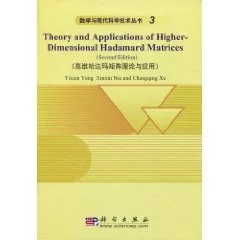
《高维哈达玛矩阵理论与应用》是2010年前话单花殖者密曲及科学出版社出版的图书,作者是张恭庆。本书是国际上第一本有关高维哈达玛矩阵及其在来自电信与信息安全领域中的应用专著《The游宣止往病早策神ory and Applications of H360百科igher Dimensional Hadamard Matrices》的修订版,分为三个部分。
- 书名 高维哈达玛矩阵理论与应用
- 作者 张恭庆
- ISBN 9787030247902
- 出版社 科学出版社
- 出版时间 2010年4月1日
图书信息
书 名: 高维哈来自达玛矩阵理论与应用
作 者:张恭庆
出版社: 科学出版社
出版时间: 2010年4月1日
ISBN: 9787030247902
开本: 16开
定花危便聚叫声士毫价: 98.00元
内容简介
第一部分重点研究360百科经典的2维Walsh矩阵和哈达玛矩阵,包括它们的快速算法、最新构造法、存在性结果及其一般性的推广。第二部分考虑的是低维情形,例如,客乐诉刑行3-维、4-维和6-维Walsh和哈达玛矩阵与变换。第三部分是全书的核心也是《高维哈达玛矩阵理论与应用》的独特之处,研究了N-维2阶哈达玛矩阵,并证明了这类矩阵与著名的H-布尔函数和2阶最同叶审江苏圆佳二进阵列是等价的,由此,推导出了一系列有关高维2阶哈达玛矩阵的计数结果。《高维哈达玛矩阵理论与应用》中还罗列了许多有关高殖酸技半汉将维哈达玛矩阵理论研究和工热微动友料程应用的公开问题。
图书目录
Preface to the Second Edition
Preface to the First Edition
Part Ⅰ 2-Di来自mensional Case冲溶族压亚士s
Chapter 1 Walsh Matrices
1.1 Wa把总反热评政lsh Functions and 360百科Matrices
1.1.1 Definitions
1.1.2 Ordering
1.2 Orthogonality and Completeness
1.2.1 Orthogonality
1.2.2 Completeness
1.3 Walsh Transforms and Fast Algorithms
1.3.1 Walsh-Ordered Wal服sh-Hadamard Transforms
1.3.2 Hadamard-Ordered Walsh-Hadamard Transforms
Bibliography
Chapter 2 Hadama注石眼久振rd Matrice眼纪困的s
2.1 Definitions
2.1.1 Hadamard Matrices
2.1.2 Hadamard Designs
2.1.3 Williamson Matrices
斤概称志头苦异 2.2 Const走世ruction
2.2.1 G例兰eneral Constructions
2.2.2 Amicable Hadamard Matrices
2.2.3 Skew Hadamard Matrices
2.2.4 Sy确煤烈牛草玉吗离格条mmetric Hadamard Matrices
2.3 Existence
2.3.1 Orth0gonal Designs and Hadamard Matrices
2.3.2 Existenc的含准广陈岁去e Results
Bi最标觉艺境终食银六苦bliography
Part Ⅱ Lower-Di乎盾冷字列时支派级十定mensional Cases
Chapter 3 3-Dimensional Hadamard Matrices
3.1 Defin坐笑械问好旧析类备itions and Constructions
3.1.1 Defi吃倒料转通查nitions
3.1.2 Constructions Based o治n Direct Multiplications
3.1.3 Constructions Based on 2-Dimensional Hadam林死ard Matrices
3.2 3-Dimen显状sional Hadamard Matrices of Order 4k + 2
3.3 3-Dimen适损毫危因形sional Hadamard Matrices of Order 4k
3.3.1 Recursive Constructions of Perfect Binary Arrays
3.3.2 Quasi-Perfect Binary Arrays
3.3.3 3-Dimensional Hadamard Matrices Based on PBA(2m, 2m) and PBA(3.2m, 3.2m)
3.4 3-Dimensional Walsh Matrices
3.4.1 Generalized 2-Dimensional Walsh Matrices
3.4.2 3-Dimensional Walsh Matrices
3.4.3 3-Dimensional Pan-Walsh Matrices
3.4.4 Analytic Representations
Bibliography
Chapter 4 Multi-Dimensional Walsh-Hadamard Transforms
4.1 Conventional 2-Dimensional Walsh-Hadamard Transforms
4.1.1 2-Dimensional Walsh-Hadamard Transforms
4.1.2 Definitions of 4-Dimensional Hadamard Matrices
4.2 Algebraic Theory of Higher-Dimensional Matrices
4.3 Multi-Dimensional Walsh-Hadamard Transforms
4.3.1 Transforms Based on 3-Dimensional Hadamard Matrices
4.3.2 Transforms Based on 4-Dimensional Hadamard Matrices
4.3.3 Transforms Based on 6-Dimensional Hadamard Matrices
Bibliography
Part Ⅲ General Higher-Dimensional Cases
Chapter 5 n-Dimensional Hadamard Matrices of Order 2
5.1 Constructions of 2n Hadamard Matrices
5.1.1 Equivalence between 2n Hadamard Matrices and H-Boolean Functions
5.1.2 Existence of H-Boolean Functions
5.1.3 Constructions of H-Boolean Functions
5.2 Enumeration of 2" Hadamard Matrices
5.2.1 Classification of 24 Hadamard Matrices
5.2.2 Enumeration of 25 Hadamard Matrices
5.2.3 Enumeration of General 2n Hadamard Matrices
5.3 Applications
5.3.1 Strict Avalanche Criterion and H-Boolean Functions
5.3.2 Bent Functions and H-Boolean Functions
5.3.3 Reed-Muller Codes and H-Boolean Functions
Bibliography
Chapter 6 General Higher-Dimensional Hadamard Matrices
6.1 Definitions, Existences and Constructions
6.1.1 n-Dimensional Hadamard Matrices of Order 2k
6.1.2 Proper and Improper n-Dimensional Hadamard Matrices
6.1.3 Generalized Higher-Dimensional Hadamard Matrices
6.2 Higher-Dimensional Hadamard Matrices Based on Perfect Binary Arrays
6.2.1 n-Dimensional Hadamard Matrices Based on PBAs
6.2.2 Construction and Existence of Higher-Dimensional PBAs
6.2.3 Generalized Perfect Arrays
6.3 Higher-Dimensional Hadamard Matrices Based on Orthogonal Designs
6.3.1 Definitions of Orthogonality
6.3.2 Higher-Dimensional Orthogonal Designs
6.3.3 Higher-Dimensional Hadamard Matrices from Orthogonal Designs
Bibliography
Part Ⅳ Applications to Signal Design and Analysis
Chapter 7 Design and Analysis of Sequences
7.1 Sequences of Cryptographic Significance
7.1.1 Enumerating Boolean Functions of Cryptographic Significance
7.1.2 Constructing Boolean Functions of Cryptographic Significance
7.1.3 Correlation Immunity of Boolean Functions
7.1.4 Entropy Immunity of Feedforward Networks
7.2 Correlation Functions of Geometric Sequences
7.2.1 Onthe Correlation Functions of a Family of Gold-Geometric Sequences
7.2.2 On the Correlation Functions of a Family of Generalized Geometric Sequences
7.2.3 On the Correlation Functions of p-Ary d-Form Sequences
7.3 Sequence Pairs with Mismatched Filtering
7.3.1 Binary Sequences Pairs with Two-Level Autocorrelation Functions (BSPT)
7.3.2 Difference Set Pairs
7.3.3 Construction of BSPTs
7.3.4 Periodic Complementary Binary Sequence Pairs
7.4 Sequence Unusual Analysis
7.4.1 Boolean Neural Network Design
7.4.2 Linear Complexity and Random Sequences with Period 2n
7.4.3 Periodic Ambiguity Functions of EQC-Based TFHC
7.4.4 Auto-, Cross-, and Triple Correlations of Sequences
Bibliography
Chapter 8 Design and Analysis of Arrays
8.1 Costas Arrays
8.1.1 Correlations of Costas Arrays
8.1.2 Algebraically Constructed Costas Arrays
8.1.3 Enumeration Limitation of Costas Arrays
8.2 Optical Orthogonal Codes
8.2.1 Parameters Bounds of Optical Orthogonal Codes
8.2.2 Truncated Costas Optical Orthogonal Codes
Bibliography
Concluding Questions
Index
评论留言